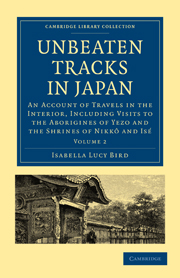 Unbeaten Tracks in Japan
Unbeaten Tracks in Japan Book contents
- Frontmatter
- Contents
- LIST OF ILLUSTRATIONS
- ERRATA
- NOTES ON YEZO
- LETTER XXXVIII
- LETTER XXXIX
- LETTER XL
- LETTER XL.–(Continued)
- LETTER XLI
- LETTER XLI.–(Continued.)
- LETTER XLII
- LETTER XLII–(Continued)
- LETTER XLII–(Continued)
- LETTER XLIII
- LETTER XLIV
- LETTER XLIV.–(Continued.)
- LETTER XLV
- LETTER XLV.–(Continued.)
- LETTER XLVI
- ITINERARY OF TOUR IN YEZO
- LETTER XLVII
- LETTER XLVIII
- LETTER XLIX
- NOTES ON TÔKIYÔ
- NOTES ON TÔKIYÔ–(Concluded.)
- LETTER L
- LETTER LI
- LETTER LII
- LETTER LIII
- LETTER LIV
- LETTER LV
- NOTES ON THE ISÉ SHRINES
- LETTER LVI
- LETTER LVII
- ITINERARY OF ROUTE FROM KIYÔTO TO YAMADA (SHRINES OF ISÉ), AND BY TSU TO KIYÔTO
- LETTER LVIII
- LETTER LIX
- A CHAPTER ON JAPANESE PUBLIC AFFAIRS
- APPENDIX
- INDEX
LETTER XLII–(Continued)
Published online by Cambridge University Press: 05 October 2010
- Frontmatter
- Contents
- LIST OF ILLUSTRATIONS
- ERRATA
- NOTES ON YEZO
- LETTER XXXVIII
- LETTER XXXIX
- LETTER XL
- LETTER XL.–(Continued)
- LETTER XLI
- LETTER XLI.–(Continued.)
- LETTER XLII
- LETTER XLII–(Continued)
- LETTER XLII–(Continued)
- LETTER XLIII
- LETTER XLIV
- LETTER XLIV.–(Continued.)
- LETTER XLV
- LETTER XLV.–(Continued.)
- LETTER XLVI
- ITINERARY OF TOUR IN YEZO
- LETTER XLVII
- LETTER XLVIII
- LETTER XLIX
- NOTES ON TÔKIYÔ
- NOTES ON TÔKIYÔ–(Concluded.)
- LETTER L
- LETTER LI
- LETTER LII
- LETTER LIII
- LETTER LIV
- LETTER LV
- NOTES ON THE ISÉ SHRINES
- LETTER LVI
- LETTER LVII
- ITINERARY OF ROUTE FROM KIYÔTO TO YAMADA (SHRINES OF ISÉ), AND BY TSU TO KIYÔTO
- LETTER LVIII
- LETTER LIX
- A CHAPTER ON JAPANESE PUBLIC AFFAIRS
- APPENDIX
- INDEX
Summary
There cannot be anything more vague and destitute of cohesion than Aino religious notions. With the exception of the hill shrines of Japanese construction dedicated to Yoshitsuné, they have no temples, and they have neither priests, sacrifices, nor worship. Apparently through all traditional time their cultus has been the rudest and most primitive form of nature worship, the attaching of a vague sacredness to trees, rivers, rocks, and mountains, and of vague notions of power for good or evil to the sea, the forest, the fire, and the sun and moon. I cannot make out that they possess a trace of the deification of ancestors, though their rude nature worship may well have been the primitive form of Japanese Shintô. The solitary exception to their adoration of animate and inanimate nature appears to be the reverence paid to Yoshitsuné, to whom they believe they are greatly indebted, and who, it is supposed by some, will yet interfere on their behalf.
Their gods, that is, the outward symbols of their religion, corresponding most likely with the Shintô gohei, are wands and posts of peeled wood, whittled nearly to the top, from which the pendent shavings fall down in white curls. These are not only set up in their houses, sometimes to the number of twenty, but on precipices, banks of rivers and streams, and mountain passes, and such wands are thrown into the rivers as the boatmen descend rapids and dangerous places.
- Type
- Chapter
- Information
- Unbeaten Tracks in JapanAn Account of Travels in the Interior, Including Visits to the Aborigines of Yezo and the Shrines of Nikkô and Isé, pp. 94 - 108Publisher: Cambridge University PressPrint publication year: 2010First published in: 1880
